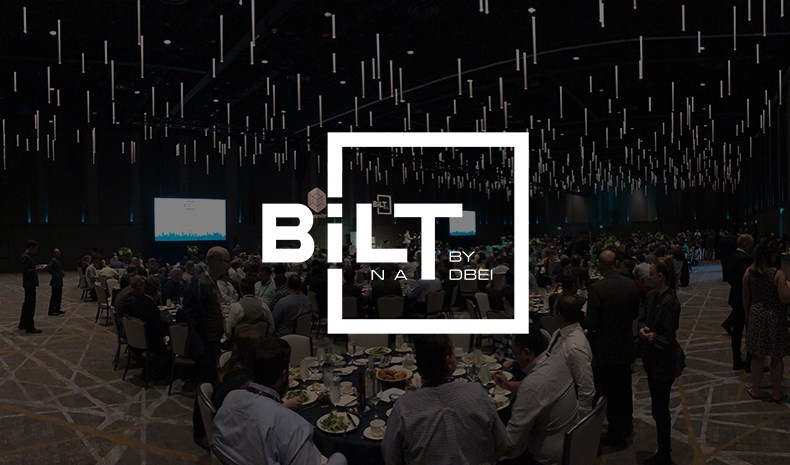It’s the end of July, and another BiLTna has come and gone.
BiLT, the annual design technology conference that takes place in several locations around the world each year, recently hosted its 2019 North American event in Seattle, Washington. With nearly 800 attendees (of which a record 20% were female and 46% were first-time attendees), BiLT always presents a diverse, yet intimate opportunity to interact with like-minded people in the industry.
But more than anything, BiLT also presents an opportunity to take the pulse of the AEC industry and get a grasp for what’s happening now and what’s on the horizon. After three days of keynotes, sessions, and conversation with our peers, our team walked away discussing several major themes that dominated the atmosphere this year at BilT. Here are three of them, and why they’re highly important conversations to have for the future of our industry.
THEME 1
Disruption
For years, experts have warned that the state of technology and innovation in architecture, engineering, and construction is lagging behind other industries.
This, unfortunately, is not new news. In fact, many of our conferences focus on this topic and highlight what the leaders in our industry are doing to catch up.
But at this year’s BiLT conference, the conversation shifted focus slightly. Rather than zeroing in on what groups inside our industry are doing to advance technology, there was much talk on what groups outside the industry are doing to bring new tech into our space.
The interesting thing about most of these groups, however, is that rather than coming up through the AEC ranks, many have dived in from other industries as conglomerates of tech and business talent seeking a window of opportunity that they see to disrupt the construction sector. As our speed of innovation continues to lag, that window grows larger and larger, opening ourselves up to more and more external parties hoping to take advantage of the gap we have been unable to close.
We as AEC “insiders” must not make the mistake of thinking that the current way of doing things cannot be overthrown.
Therefore, the issue presented at BiLT was this: If the gap between construction and other sectors continues to widen, so will the opportunity for external disruptors to enter the picture. At that rate, it's anyone's guess how long we can continue at the current pace of innovation before the established system is overtaken by industry outsiders.
As a picture of what an industry ill-prepared for disruption can look like, the story of Eastman-Kodak's downward spiral came up during one of the keynotes. For Kodak, the rise of cameras on mobile phones came unexpectedly and they never recovered. In their case, one simple trend from outside the immediate competitive market (cell phones in those days had not yet been considered competition for a camera company) was all it took to change Kodak's trajectory permanently.
In the same vein, we as AEC “insiders” must not make the mistake of thinking that the current way of doing things cannot be overthrown. Just because things are done a certain way does not mean that there are not better ways – and those outside the industry are sometimes the ones most poised to see them.
BiLT suggested that the only way for insiders of the AEC industry to be protected from the threat of disruption is not to try to weather the storm and continue on as we are, but to accept the need for substantial change and meet opportunistic outsiders with disruption of our own.
THEME 2
Leadership
This prospect of disruption in the AEC sector leads to the second major topic arising from BiLT – a clear and present need for strong leadership to continue to drive our technology forward.
If you’ve ever attended BiLT, the people that show up each year are undeniably leaders. They’re the ones pushing the envelope in their firms when it comes to technology and innovation. They’re BIM Managers, Chief Technology Officers, Design Technology Directors, and others, not to mention the vendors and software companies who strive to equip those people with the tools necessary to succeed.
Without exaggerating, it’s safe to say that BiLT brings the AEC industry’s most powerful technology influencers in North America to one place at one time. It’s quite possibly the single best opportunity to inspire and effect change in our firms for the coming year. The greatest shame would therefore be to waste the opportunity and return to the office with nothing to offer.
This subject came to the forefront in the Friday morning BiLT opening session. The main event was a live podcast interview of Steve Burrows, a seasoned tech and business veteran and former executive of multiple AEC ventures, including AECOM and Katerra. (Listen to the full interview on the Art of Construction podcast.)
The real need in the industry is not better technology or better data, but better leadership.
When asked his opinion on various advances in technology, including AR/VR capabilities, Burrows acknowledged their importance but stressed that the real need in the industry is not better technology or better data, but better leadership. According to Burrows, the real reason that AEC is lagging behind other sectors is that we are missing truly effective leaders that can utilize technology in bigger and more impactful ways than ever.
In his words, “We’re not here to be followers. We’re here to be leaders.”
At BiLT, an event focused on leadership in technology, the idea therefore resonated that our focus may be too heavy on the latter and not enough on the former.
Steve Burrows on @katerrainc and the necessary shift for the #AEC industry if it is going to keep up with the pace of innovation in other sectors: “We’re not here to be followers. We’re here to be leaders.” #dbwna #biltna @BILTevent @TheAOCPlatform pic.twitter.com/VoSqWrnyeB
— BIMsmith (@thebimsmith) July 19, 2019
Burrows left the BiLTna audience with a challenge to pursue leadership within our companies as vigorously as we pursue technology. In accordance with that challenge, as leaders we might each consider the following questions as we return to our workplaces:
1. What are we doing to train up leaders in our firm?
2. Does our firm provide an open environment for creativity to thrive and natural leaders to rise to the top?
3. Does my own leadership inspire others to be leaders and changemakers?
THEME 3
Macrocollaboration
The third theme from BiLT 2019 brings both the first and second together and is best summed up in a word that attendees probably didn’t hear once (and to our knowledge probably isn’t even a real word).
The word is macrocollaboration.
While “collaboration” tools have dominated our conferences for the past few years, that’s not what we’re talking about. Those tools primarily focus on connecting data and resources internally between members of the same team. In this case, one might think of those as “microcollaboration” tools.
Macrocollaboration, on the other hand, is quite the opposite. Macrocollaboration involves the joining of powers, tools, and resources at a higher level – throughout an entire industry, for example – to bring about change that is greater than any one party could effect individually.
In an industry where macrocollaboration is strong, different groups all adopt their roles as spokes around a central “hub” of innovation.
This theme emerged in full force at the end of BiLT at the closing Gala, where BIMsmith CEO Benjamin Glunz delivered a keynote address with the theme “Connected”. The address described the traditional “hub and spoke” approach to doing business, where groups tend to focus exclusively on their own "hub" of ideas and only incorporate third party efforts as "spokes" in their wheel.
This method has been the default for years. But the question posed at BiLT was whether a more collaborative approach might serve the industry more effectively.
In an industry where macrocollaboration is weak, multiple parties end up competing to be the hub and fighting against friction caused by other parties pushing their own agendas. In an industry where macrocollaboration is strong, different groups all adopt their roles as spokes around a central “hub” of innovation.
“Our industry doesn’t work unless we look at things differently and connect our knowledge and our tools.”
— Ethan Adams (@UpAndAdams) July 21, 2019
-@bfglunz at #BiLTna #DBWna #BIMsmithConnected #BIMsmithGala pic.twitter.com/xlRe1Fhqod
The fear for many, of course, is that to be a "spoke" may require them to sacrifice the value they can offer through their own ideas and tools. However, the opposite is actually true. Because macrocollaboration counterbalances the competitive drive for proprietary innovation with a culture of shared knowledge, rather than stripping proprietary tools of their value, openness and collaboration can actually make them more effective – and therefore more valuable.
The "hub and spoke" approach may be the most natural strategy for our industry, and it may remain so for years to come. However, we must ask ourselves whether a culture of macrocollaboration, where people, tools, and companies form bridges to one another that advance the industry as a whole, might be the mental shift we need in order to get our industry's progress back on track.
Leading the Way After BiLT
The call to action from BiLT 2019 is therefore one of tremendous opportunity.
It’s a call for the entire AEC industry, from architect to contractor to software provider, to consider not just our roles in driving change within our companies, but throughout the entire industry. Our industry is in increasingly clear need of disruption, and it’s up to each one of us to decide whether we’ll be the ones to do it or sit and watch it pass us by.
If we choose to take action, it will require not just inspired creativity, but distinctive leadership and a willingness to collaborate on a larger scale than ever before. It will require each of us to identify our role as spokes around a common hub, as neurons working together in a powerful network.
It will require much of each of us, but it just might make all the difference.
--
Ethan Adams
 BIMsmith is a free cloud platform for architects, designers, and building professionals to research, select, and download building product data. Search, discover, compare, and download free Revit families on BIMsmith Market, build complete, data-rich Revit wall, floor, ceiling, and roof systems faster with BIMsmith Forge, or bring them both into your Revit workflow with the BIMsmith Revit Plugin.
BIMsmith is a free cloud platform for architects, designers, and building professionals to research, select, and download building product data. Search, discover, compare, and download free Revit families on BIMsmith Market, build complete, data-rich Revit wall, floor, ceiling, and roof systems faster with BIMsmith Forge, or bring them both into your Revit workflow with the BIMsmith Revit Plugin.














